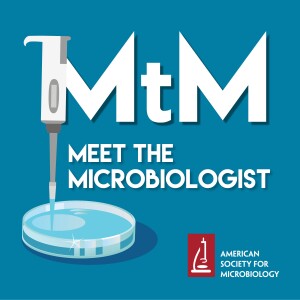
076: Evolution of bacterial biofilm populations with Vaughn Cooper
 2018-02-15
2018-02-15
Most bacteria live a sedentary lifestyle in community structures called biofilms. Vaughn Cooper tells us what bacterial biofilms are, why biofilms differ from test tube environments, and how long-term evolution experiments combined with population genomics are teaching us how bacteria really work. He also discusses using hands-on bacterial evolution activities to introduce high schoolers to future STEM possibilities.
Host: Julie Wolf
Subscribe (free) on iPhone, Android, RSS, or by email. You can also listen on your mobile device with the ASM Podcast app.
Julie's biggest takeaways:
Cells in a biofilm shift to dedicate their resources to protection rather than reproduction. This allows biofilms to be innately more resistant to antibiotics than those growing in planktonic culture.
One of the least-understood parts of a biofilm cycle is the dispersal stage. What cues or signals influence some biofilm-embedded cells to leave? This is a vital part of biofilm formation, since these dispersal cells can eventually attach to a new surface and restart the process of forming a biofilm.
The bead system of biofilm propagation allows Vaughn and his colleagues to study the long-term evolution of biofilms. This system, combined with population genomics, allows the study of all the different genetic changes within the population.
Traditional genetic screens compare libraries of mutants to see which survive under different conditions. Rather than on libraries of mutant strains, evolution works on random mutants that arise naturally. The accessibility of sequencing technologies has changed the way scientists study evolution, as now the mutations can be found as they form, rather than being seeded into the initial mutant library screen.
High schoolers using nonpathogenic bacteria can study evolution in action by developing new colony morphologies. Work with high schoolers and their teachers has shown students who do hands-on learning do better on standardized tests and that girls, especially, express higher interest in technology and an interest in STEM careers after a 1-2 week project.
Featured Quotes (in order of appearance)
“From a perspective of an ecologist and evolutionary biologist, this is what captivated me about biofilms: that instantly in the process of forming a biofilm, the environment becomes heterogeneous. Different cells that are clone mates are experiencing different selective pressures.”
“The hypothesis that we’ve been testing for the last 15 years or so is that biofilms in and of themselves may generate ecological and heritable evolutionary diversity in really short periods of time.”
"In describing the wrinkled Pseudomonas colonies that can stem from biofilm cells: “I think they look like hydrangeas, and some look more like doilies. I think they’re captivating and pretty charismatic as far as microbes go.”
“The average bacteria picked from any environment does an unbelieveably good job of protecting its genetic material. The per-cell mutation rate, per-genome, per-generation rate is about 1 in 1000 cells. So a bacterial cell needs to divide about 1000 times to create a single mutant. That means that mutations are actually relatively scarce, but bacterial populations are extraordinarily immense. If you grow a single cell to 108 cells, you’ve got about 105 new mutations. That’s a pretty large number. Some of them, maybe a handful, maybe 1/100 of those 105 mutations, which would be about 1000, would be beneficial. Then selection will act on them, and the better ones will rise more quickly because they make more progeny. And that’s evolution in action!”
“Increasingly, we’re using evolution to teach us about how the organism works.”
“I’m not saving lives with any of our studies on microbes in biofilm-associated infections just yet. We are seeing how they change in these infection and how they become more drug resistant. That’s great, and I think that’s a valuable contribution. But when we can encourage hundreds of high schoolers to really consider careers in the life sciences or mathematics or engineering, we’re changing lives.”
Links for this episode
Vaughn Cooper University of Pittsburgh website Rich Lenski Long-Term Evolution Experiment ASM video Journal of Bacteriology cover featuring Pseudomonas colonies Journal of Bacteriology report on the evolution of Pseudomonas biofilm diversity Journal of Bacteriology tribute to Bill Costerton Bill Costerton YouTube interviewSend your stories about our guests and/or your comments to jwolf@asmusa.org.
More Episodes
 2022-10-01
2022-10-01
 2021-06-10
2021-06-10
 2020-04-23
2020-04-23
 2020-01-10
2020-01-10
Create your
podcast in
minutes
- Full-featured podcast site
- Unlimited storage and bandwidth
- Comprehensive podcast stats
- Distribute to Apple Podcasts, Spotify, and more
- Make money with your podcast
It is Free
- Privacy Policy
- Cookie Policy
- Terms of Use
- Consent Preferences
- Copyright © 2015-2024 Podbean.com




